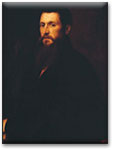| |
Hockney | Stork | Experts | Assumptions | Camera-obscura | Italians | Caravaggio | Camera | Inquisition | Mirror-lens | Conclusion | Notes
The Italians lead the camera obscura charge in the Fifteenth Century
| |

A portrait of Daniele Barbaro (1545, Museo del Prado) executed by Titian. Could this small painting, 81 x 69cm, have been done using a camera obscura?

|
Although Aristotle, Euclid and the Chinese all knew about the camera obscura effect, and the eleventh-century Arab mathematician Abu Ali Al-Hazen ibn Alhazen (d.1038 Cairo) wrote extensively about it, it was the Italians in the sixteenth century who really made strides in developing this natural phenomenon towards what would eventually become the modern camera. A Milanese mathematics professor, Girolamo Cardano (1501-76), was one of the first (1550) to write about the use of the biconvex lens as an improvement in relation to the camera obscura. Venetian nobleman, Daniele Barbaro (1513-1570), was able to describe a camera obscura fitted with both a biconvex lens and a diaphragm (1568). This was the forerunner to the automatic aperture in modern photography, the diaphragm being made progressively smaller to sharpen the focus of the image. Neapolitan scientist Giovanni Battista Della Porta (1538-1615) also wrote extensively about the camera obscura in the two editions of his book called Natural Magic. He gave advice on how artists could use his inventions, from the making of accurate copies to the execution of lifelike portraits. Venetian Barbaro also had suggestions on how to make the image crisper, by reducing the aperture as well as moving the support (for drawing) backwards and forwards.20 Moving the support backwards and forwards? Isn’t that what Hockney claims Caravaggio did with the Supper at Emmaus? Here is a fifteenth-century writer suggesting this is exactly what artists, using the camera obscura projection, should do. This does not prove that Caravaggio (1571-1610) either used the camera obscura, or even knew about it, but the chronology becomes compelling that he could have. What Hockney has failed to do however, is to establish a specific link with Caravaggio. He says that the knowledge was a closely guarded secret, so how could Caravaggio have known about it, and how could the knowledge have not been known about when Della Porta was writing about it, and publishing around the time Caravaggio first went to Rome?
< Previous Next >
|

